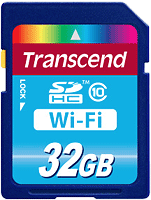Cable-free future gets more affordable: Transcend debuts Wi-Fi-capable flash memory
posted Monday, November 12, 2012 at 6:05 PM EST

The future of digital cameras, it seems, is wireless: more and more camera models are shipping with built-in wireless connectivity that lets you share photos straight from the camera via a smartphone, tablet, or convenient Wi-Fi network. Social networks like Facebook and their ilk are where many of us do our photo sharing these days, and a camera reliant on cables is a camera that makes sharing your photos harder than it needs to be. Of course, we can't all justify replacing our cameras just to cut out the cables, and so other solutions to the problem exist.
What to do if your camera lacks built-in wireless connectivity? The answer is a Wi-Fi-capable flash memory card, and the name that instantly comes to mind is the connected memory card industry's pioneer, California's Eye-Fi Inc. After having the market to itself for quite awhile, Eye-Fi is starting to see increasing competition of late, and a new rival has just arrived in the form of Taipei, Taiwan-based Transcend Information Inc.
Unlike the FlashAir card line launched by Toshiba late last year, Transcend's new Wi-Fi-capable SD cards don't seem to be based on the SD Association's Wireless LAN SD specification -- or at least, if they are, they lack any sign of the branding and certification logos that the standard defines.
Transcend offers its Wi-Fi SD cards in two capacities: either 16 or 32 gigabytes. The cards bear an SDHC Class 10 speed rating, and Transcend says they're compatible with a healthy selection of camera models from Canon, Casio, Fujifilm, Nikon, Olympus, Panasonic Pentax, Samsung and Sony. (See the full compatibility list here.)
The cards support connecting both to the Internet via public access points or the hotspot functionality found on some smartphones and tablets, as well as your mobile devices via peer-to-peer connection, also known as Wi-Fi Direct. For Internet mode, supported network security types include WEP, WPA and WPA2; Wi-Fi Direct network connections only support WPA2 encryption. Compatible network types include 802.11 b / g / n, but not 802.11a, nor the newer 802.11ac / ad.
A nice touch for Transcend's cards is the availability of an app for Android and iOS devices that lets you view photos instantly after they've been transferred to your phone or tablet; Transcend calls this the Shoot & View feature. The Wi-Fi SD cards support transfer of JPG, BMP and PNG still images, and AVI, MOV, MP4, M2T, MTS or M2TS video files, but sadly, there seems to be no support for RAW data transfer.
Pricing is set at about US$70 for the 16GB card, or US$100 for the 32GB card. By way of comparison, Eye-Fi's cards currently reach a maximum of 16GB, and cost US$100 at that capacity. For US$60, you can pick up an 8GB Eye-Fi card, but this has a slower Class 6 speed rating. Toshiba's FlashAir cards so far aren't widely available in the U.S., and seem to carry similar pricing to Eye-Fi's cards. They're also limited to a maximum capacity of 8GB so far.
Other rivals include Trek's Flucard Pro and LZeal's ez Share, but these also seem to have an 8GB limit and pricing closer to Eye-Fi's cards, plus more limited U.S.-market distribution. If Transcend's cards prove reliable and they can get them in consumer's hands, their price and capacity advantage could make them popular indeed.
At press time, Transcend hadn't revealed its distribution plans, nor an availability date for the new cards.